The Story Of Iso Joe: The Evolution Of A Scorer

Below is a lightly modified transcript of episode six of the Breakaway podcast, entitled “Transformation.” You can listen to the episode in its entirety here.
It all starts with identity. Every NBA career is rooted in it. Whether conscious or not, draft prospects spend years projecting a particular image. One is a poised, confident floor general. Another a skilled face-up threat. There are tenacious on-ball defenders, and raw, athletic wings—there’s a bucket for every kind. We reduce players to these common denominators as a way of trying to understand the chaos of the game. When there are too many variables to really make sense of it all, you can start by making everything uncomplicated.
The catch is that the league itself never sits still. So whatever a player’s identity is, it’s relative—to their team, to the evolution of the NBA, and maybe most of all: to the arc of their career. Some of the greatest to ever play came and went playing more or less the same style. Think John Stockton or Kobe Bryant. For everyone else, sticking around requires frequent redefinition. Jason Kidd and Vince Carter had to rework their games multiple times. It’s not just shifting from one thing to the other.
“It was all different stages,” Johnson said. “That's kinda how I look at it.”
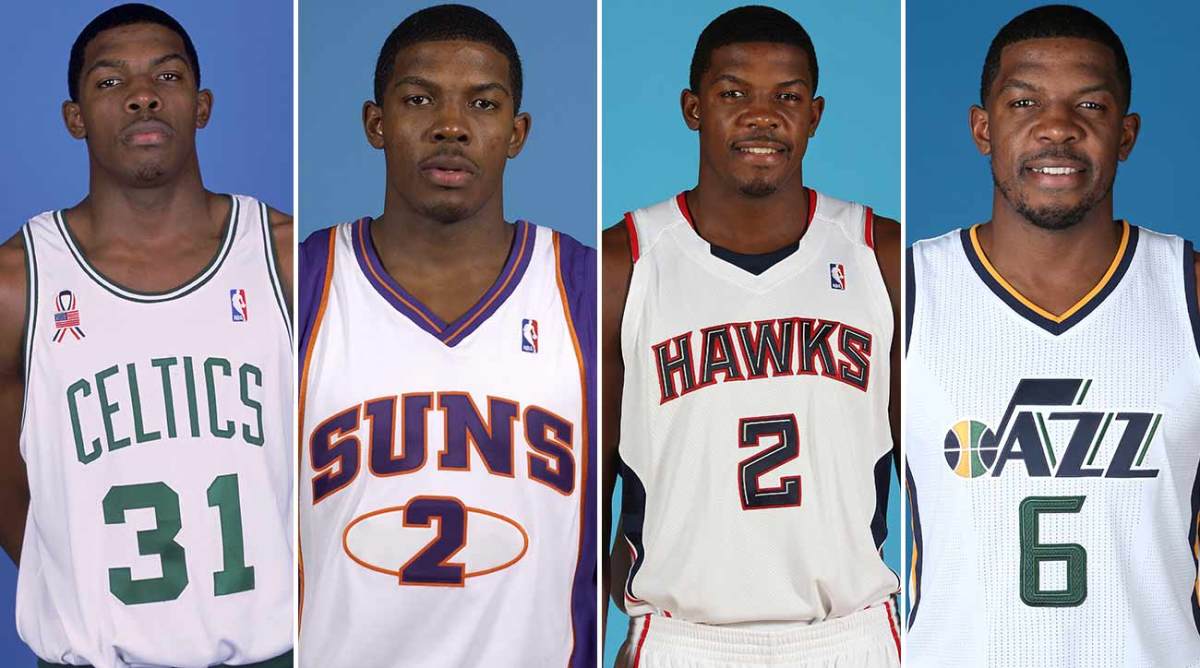
Johnson is a seven-time All-Star who has played all over the spectrum. Fast and slow, post and perimeter, centerpiece and supplement. The player Johnson is now was made gradually. He’s played for six teams, each wanting something totally different. Johnson found the space in his game to accommodate all of those requests, building layer upon layer of basketball utility.
“I didn't have everything that I would say I got in my game now when I was a young player,” Johnson said. “Like, I wasn't a great pick-and-roll guy, I wasn't a great post-up guy. Y'know, I had to develop all those things. And early on in my career, like I said, I was just happy to be out there playing. I wasn't really concerned about being the best pick-and-roll guy or being the best one-on-one guy or being the best post guy. I wasn't even posting early in my career. So as the years kinda went along, obviously as you get a little older, man, you start to realize—you start to lose a step. So you have to add different things in your game.”
Like he said: it came in stages. And at every stage, Johnson came out transformed.
Having seen the full breadth of Johnson’s career, you almost forget that he came into the league thin, and quick, and—like most rookies—a little bit rudderless. But scouts and peers saw the same promise. When Johnson’s game clicked, he was smooth and productive. When it didn’t, he could fall through the cracks of the game as a non-factor.
Landing on the right side of that scale was Johnson’s first priority after being drafted by the Celtics. Boston had three first round picks in 2001: Johnson at 10, Kedrick Brown at 11, and Joe Forte at 21. And not only were they teammates—they were neighbors. The three rookies all lived in the same apartment complex, so they’d get together to play video games, stay up all night, and relive their college years.
“We became super tight,” Johnson said. “And I just remember Jim O'Brien at the time, he had just gotten the head coaching job with the Boston Celtics and he came to us three one day and he was like, 'Man, you know, two of you guys are gonna have to sit on IR. You're gonna have to take turns.' And I'm thinkin' to myself: Sh--. Man, if I have to destroy these guys every night, man I'mma come out and destroy 'em cause I wanna play.”
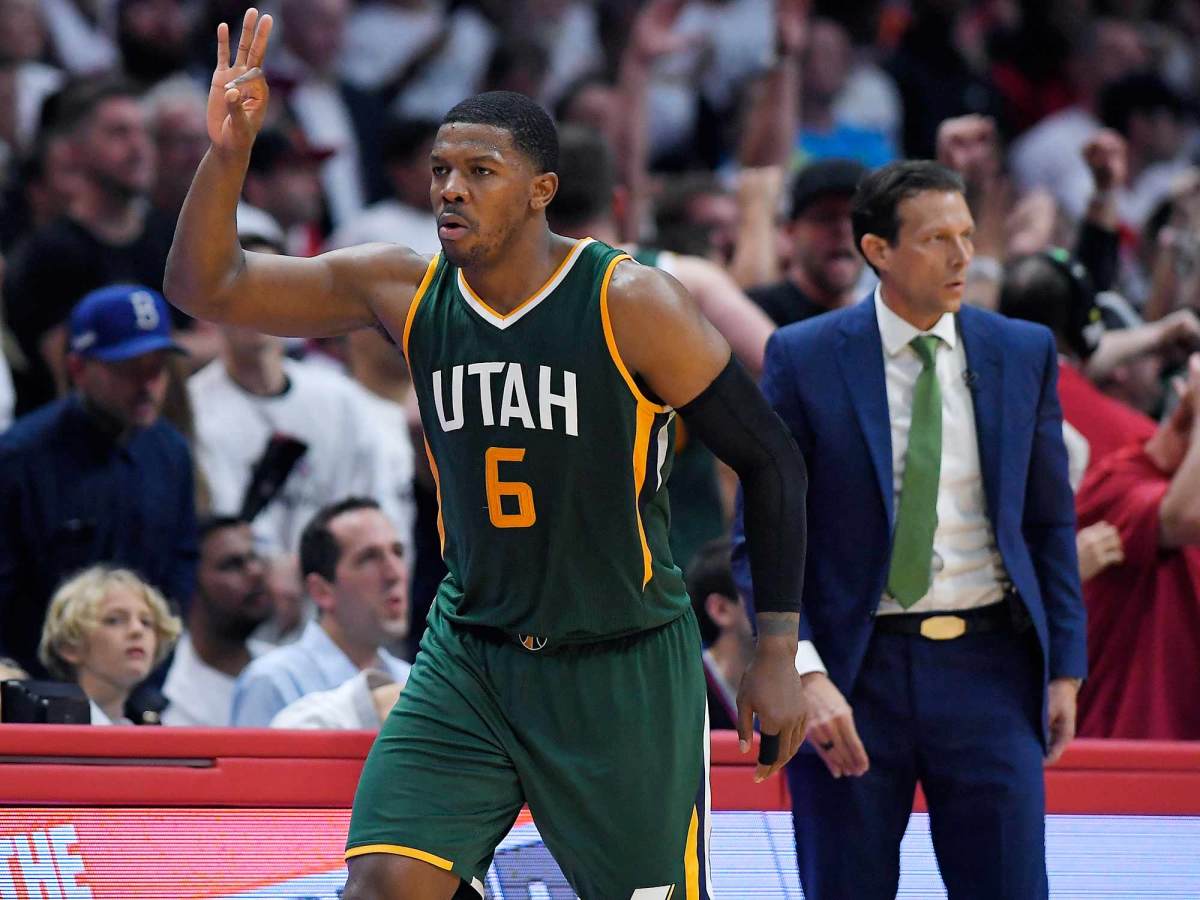
O’Brien apparently saw enough. Johnson got time right off the bat and even more when Eric Williams, a starter on the wing, went down with injury.
“I’m playing with Paul Pierce, Antoine Walker, Kenny Anderson,” Johnson said. “You know, I got some guys on my team who're gettin' 'em up. But man, I was very efficient but I never even looked at it from that standpoint. I was just happy to be out there playing, man. I'm living out my dream and I was just trying to make the most of it.”
The way to make the most of it was to defend. Johnson took the thankless work of hounding the best opposing wing for most of the game—a responsibility he would cede to Pierce in crunch time. That kept Pierce fresh to create offense and maximized Johnson’s effort level. He was a specialist—a 6-7 guard who could keep his man square at a time when the wing depth in the league was just murderous.
“This is when Michael Jordan came back and played with the Wizards,” Johnson said. “I'm guardin' Michael Jordan like fourth game of the season, I'm starting guarding him. Playing against T-Mac, Vince Carter, Kobe Bryant, like—that was, that was huge for me. So these are guys who I idolized coming up, man, and who paved the way for me. And now I'm out here on the same floor with 'em. Man, I was geeked. I was geeked.”
The Important Adjustments From Spurs-Rockets Game 2
It’s never ideal to throw a rookie into a fire quite that scorching, but the balance worked. Johnson filled in as a low-usage, high-energy stopper, Pierce went on to have an All-Star season, and the Celtics were finally breaking through as the second-best team in the East. Then came the kicker: Once Boston was really in a position to make a push, they traded Johnson away for more veteran help. The whole experience blindsided him.
“I had no clue I was getting traded,” Johnson said. “It was just, we was on a road trip, we was in Dallas, about to play Dallas, and coach called me up to his room one morning and he told me I'd been traded. That's when everything just kinda clicked, like I'm really going to a whole ‘nother team in my rookie season. I'm like, I don't wanna be no journeyman.”
“I just knew I had to go to another group of guys. I had to develop their trust. I had to learn a whole new team, a whole new system. And midseason as a rookie that's—man, that's a lot. You know? But it really opened my eyes to the business side. And then I was thinking like, man, I wonder why Boston traded me? Was I not good enough? Man, we was solid. We was like #2 in the East. They hadn't even made the playoffs the previous three years. So I'm like, dang. I really didn't understand it until like, man, honestly it took til about my fifth or sixth year in the league. As a young guy, when you develop that type of value to yourself and they're making a deep playoff run or feel like they can make one, then you're a great asset to be traded.”
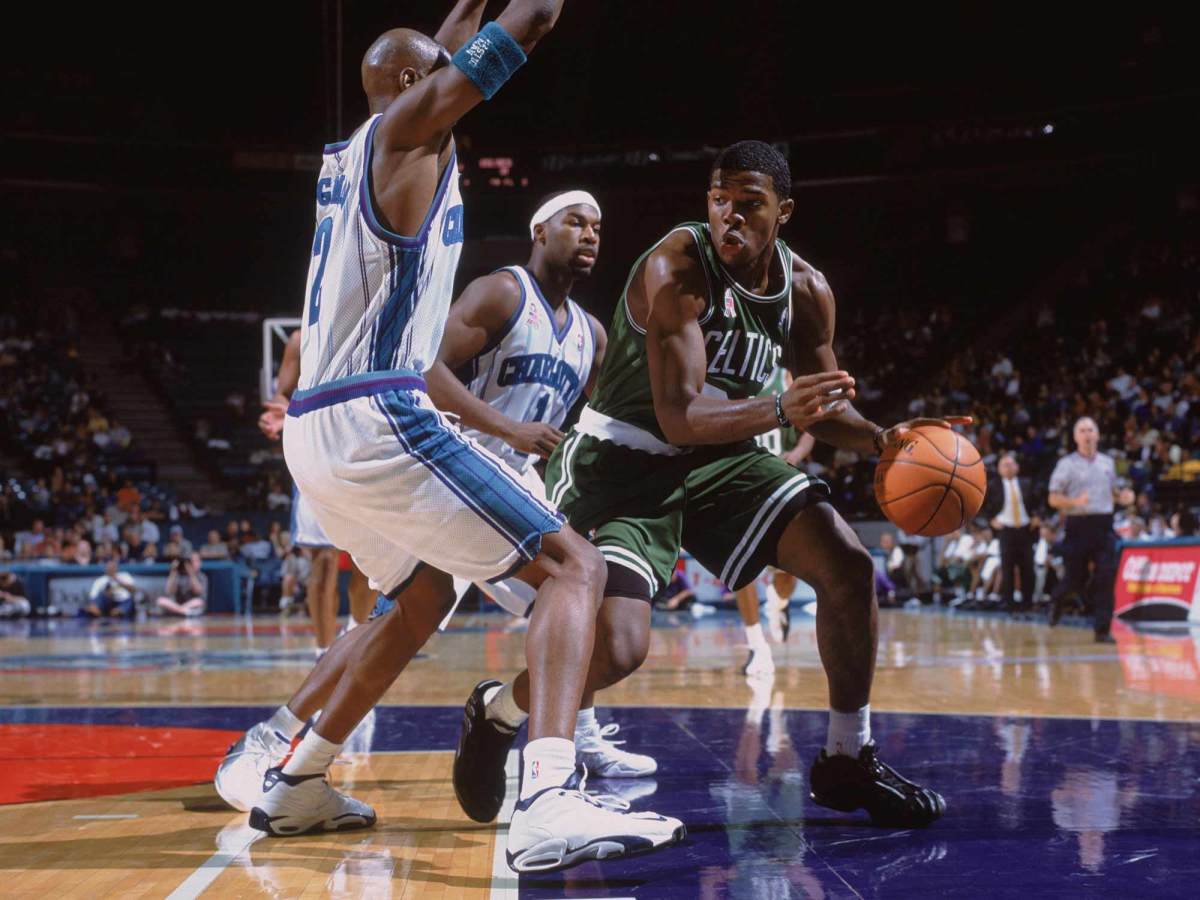
They don’t exactly lead with that information at the rookie seminar. Cracking the rotation is a reasonable goal for a first-year player. Those that do and manage to play well tend to draw interest—the kind that could tempt a competitive team looking to accelerate its timeline. Boston gave in. By doing so, it gave Johnson a personal introduction to the business of basketball.
“I wasn't mad or bitter about it,” Johnson said. “It's just kinda what it was.”
On arrival, the Suns already had Johnson doing more than he ever had in Boston. There was a little more open air out in the desert; Phoenix immediately moved Penny Hardaway to the bench and cleared a path for Johnson to handle the ball. These were the Stephon Marbury days—before Steve Nash and Mike D’Antoni, a time of convincing mediocrity. The stakes were low enough that Johnson, inconsistent as he was, could play a more operative role. His minutes jumped to over 31 a game over the back half of his rookie season. With that came steady involvement. Over the summer, Phoenix drafted Amar’e Stoudemire—a talent so clear he recontextualized the team’s entire plans almost immediately.
Things were incremental for Johnson as a Sun—he’d get a bit more rope every season to run pick-and-roll or create for himself. Only some of it worked, but the trial was the point; you can’t know what a 21-year-old can really accomplish until you let him go. A few months into Johnson’s third full season in Phoenix—and the year before they’d sign Nash—the Suns bought into that idea wholesale.
“Before we got those guys, the season before we got those guys, we traded Penny and Steph,” Johnson said. “So that just opened up the door for me and Amar'e to, y'know, explore, and evolve into the players that we can become.”
Part of that exploration involved Johnson cranking up his shooting frequency while playing over 40 minutes a night. The pace of the team went with him; D’Antoni took over as interim head coach in the middle of the season, thrusting Phoenix into the run-and-gun era before it really had the pieces. Johnson started plugging holes. Fewer of his shots were assisted than ever, because once Marbury was out of the picture, Johnson became the most reliable entry point for the offense. He led the team in assists while giving D’Antoni an alternative to a wild rookie starter named Leandro Barbosa.
It goes without saying that Nash changed everything for the Suns—including the shape of what was needed from Johnson. The power in adding him came in how it shifted and complemented the talent already in place.
“I looked at the lineup Phoenix had,” Nash said. “It felt like I’d be a great fit and that we’d develop into a contender.”
Sure enough, they did. Johnson’s role was split. When Nash was in the driver’s seat, Johnson ran his lane straight to the three-point line. His greatest contribution came in keeping the floor spread. But when Nash sat, Johnson was next in line in terms of running pick-and-roll and getting the offense in action.
“Then when we got D'Antoni as a coach, he was probably, probably the best person for me, so to speak, because he just let me play,” Johnson said. ”It wasn't, it really wasn't a structure. It was like, man, just go out there and play. Have fun. I was playing, starting at the two guard but backing up Steve Nash at the point so I was, I was doing virtually anything I wanted. It was fun, man. The game was fun.”
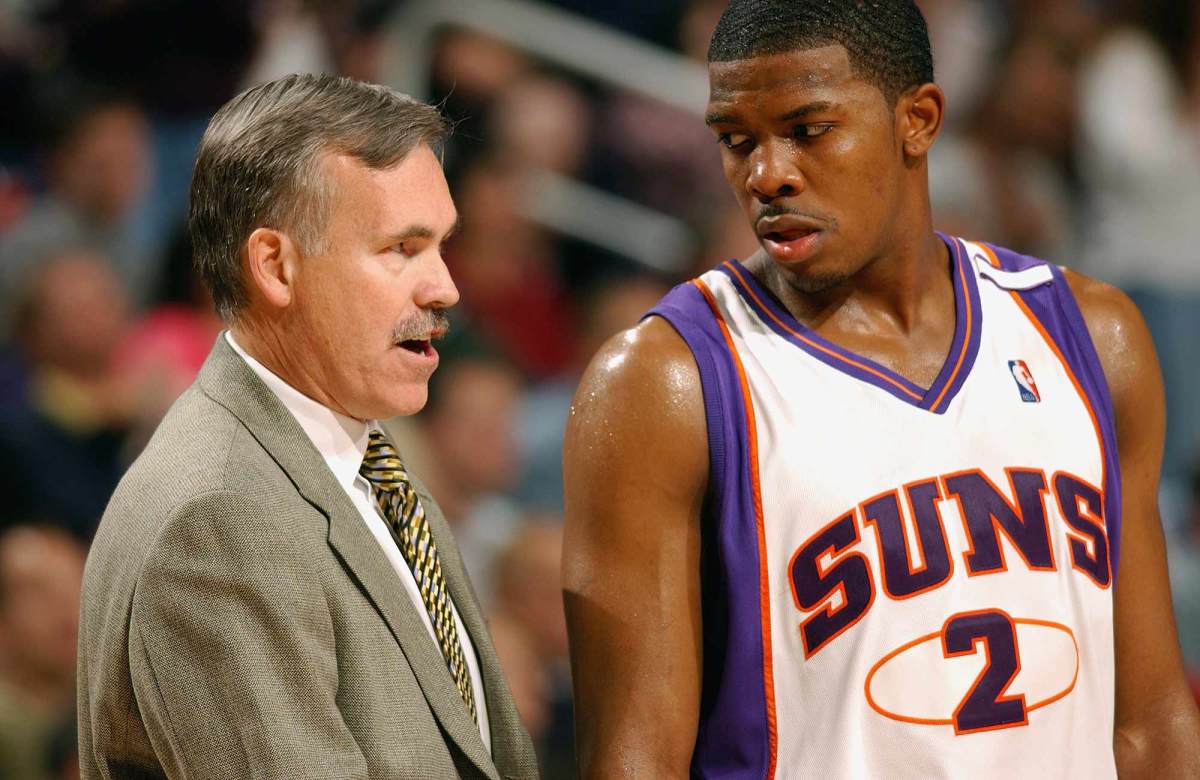
But let’s circle back for a second. Over the course of his career, Johnson has earned a reputation as a shot-maker—albeit more for hitting game-winners and fadeaways than anything else. But back in 2005, he put together a fantastic season of spot-up shooting.
“Yeah, I was like right behind Fred Hoiberg for like second in the league in three-point percentage,” Johnson said. “It was, it was crazy.”
No, no, no. Not second-behind-Fred-Hoiberg crazy. Try top-five-three-point-percentage-in-a-single-season-ever crazy. And at the time, only two players in NBA history had ever shot better than Johnson’s 47.8% on a similar number of attempts. It was kind of an improbable development. Johnson had never come within 10 percentage points of that new high-water mark in any previous year, largely because perimeter shooting had been as inconsistent as any other part of his game. Nash’s delivery and D’Antoni’s system gave him a boost, but Johnson also committed to working on the durability of his mechanics.
The NBA Playoffs Are Boring The Warriors
“Phil Weber, who was an assistant coach at the time, after every practice man, me and him would be in the gym,” Johnson said. “Not only getting extra shots up, but we had the heavy ball. At the time, I'm not even sure they had like the heavy basketball they got like now, we was using a medicine ball. And I would shoot like with a 25-pound medicine ball, I had to make like 150 shots after every practice. My arm would be wore out. So I had to do it after every practice. I dreaded it. I hate seeing him. And that's what it was. He made me do it after every practice, man, and it paid off. It paid off big-time.”
Each player’s struggles with inconsistency are his own. For some it’s a crisis of confidence—the existential trouble of being a professional basketball player who can’t see a ball through the hoop. For Johnson, stability came through comfort on both sides of his role and the physical honing of his most important skill.
Now Johnson was a bothersome defender, a part-time creator, and an altogether more reliable range shooter. That’s more than enough to get a player paid—and a big part of the reason why Johnson became an Atlanta Hawk. The want to leave what was a pretty satisfying work environment in Phoenix started as an itch.
“I just knew that I was a better player than what people knew,” Johnson said. “I wanted to evolve my game, man, and be more—have a bigger role on a team. That's pretty much what it was.”
The Suns couldn’t reasonably accommodate that. Nash was transformative because he made the offense fly, but he needed the ball to do it. And then there was Stoudemire, who beamed with possibility. Behind them, Shawn Marion—who was one of the league’s best all-around players—would occasionally grumble about his own billing. There was little left to reallocate and, after a 62-win season, little reason to budge.
Johnson’s eyes started wandering. But a lot of the interest around the league was tempered by the fact that Johnson was a restricted free agent, meaning any offer sheet he signed could then be matched by the Suns. The Hawks, who were desperate to add talent, couldn’t be deterred.
“They were just persistent, that whole year,” Johnson said. “I had a few other teams involved but Phoenix kinda scared 'em off cause they were tellin' em, man, there's no need for you guys to try and sign him cause we're gonna match. A lot of teams ran. Atlanta stayed. They was like, 'We don't care. We're staying. We're gonna offer such and such,' and that's just kinda how it happened, man. They made the offer and probably one of the hardest things, I had to sit—I had to get on the phone with Robert Sarver who was in his first year owning the team and tell him, 'Man, look. Just let me go. Don't match. Y'know, I just want a bigger role for myself. I think this is a great fit for me.' And I don't think he wanted to do it but he did it, man. He didn't match.”
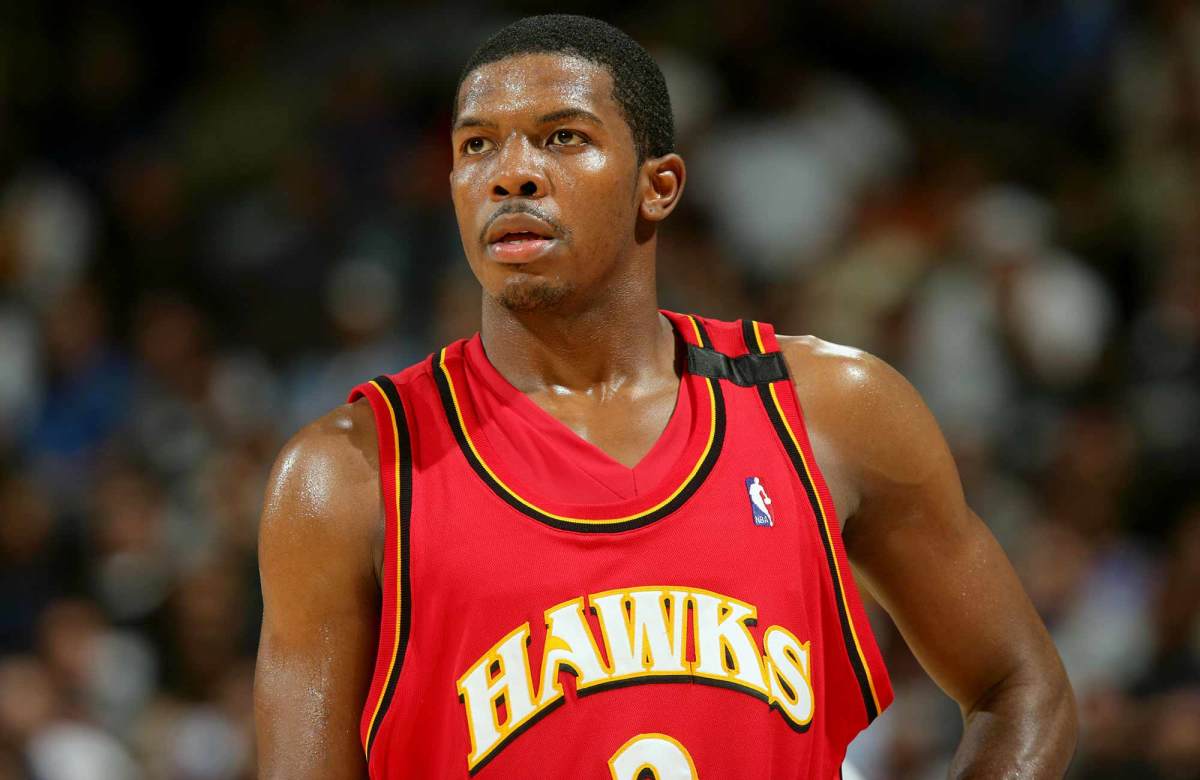
Sarver altered the course of Johnson’s career. It was one of those things that was unknowable at the time—in part because the full ranges of Johnson’s game were still a bit unknowable. The Hawks didn’t care. They saw an emerging player who had shown he could do a little bit of everything and wanted to put him in a position to do a whole lot of everything. Atlanta didn’t want another nice piece—it wanted a star to put nice pieces around.
Those opportunities only come so often for role players. It’s another snag of identity; players are asked to change constantly, but they carry certain conceptions around like a lead weight. Consider Johnson: 24 years old, and his best NBA season came as a fourth option on what some considered to be a gimmick offense. Had the Suns matched his offer, every passing year would have quelled interest for other teams in trading for Johnson and trying him at something new. Do any one thing for long enough in the NBA and your reputation crystallizes around you. Whatever Johnson eventually became, he became because the Hawks never let his game set.
The idea, from the start, was to unlock Johnson’s game through transposition.
“They brought me over there to play the point,” Johnson said. “And in that draft they had Chris Paul and Deron Williams and they took Marvin Williams second. They was like, 'Man, we're just gonna be 6-7, 6-8, 6-9 across the board. We're gonna switch everything. This is how we're gonna do.' So the first year I played point guard, averaged 20 and like 7 assists, and man—that was an eye-opener my first year because we started off like 2-26. I was like, 'Man, I just come from winning 62 games. Goooollly. It was miserable, man. It was miserable. I can honestly tell you I had second thoughts about my decision.”
The Hawks actually started off 2-16, but Johnson’s larger point stands: Opportunity can be bittersweet. Getting a chance to run your own team for the first time almost necessitates that the team be awful; playoff-ready clubs aren’t usually in the habit of handing over the keys to the unproven. Not only that, but Johnson had to climb the usage curve against years of instinct. Players get used to the rhythms of the game from particular angles: when to push, when to fall back, and all the unconscious shorthand of team play. Taking on the kind of responsibility that Johnson did in Atlanta—especially after just being part of the tapestry in Phoenix—required some pretty considerable reprogramming.
Biggest Surprises And Disappointments From The NBA Playoffs
“I had to work my way up into it,” Johnson said. “Cause I remember we started off in the preseason with Atlanta and I was just kinda coasting, going through the motions. I remember coach Mike Woodson came to me, and he was like, 'Hey, I need to see more out of you.' Basically: We done spent all this money, like, [laughs] we need to see what you've got. Just kinda from that point on, man, I was like, Alright, look. I'm comin' out, I'm handling. First I'm trying to get guys involved. Then I'm trying to score. I wasn't that efficient my first year but I averaged 20 and 7. It was the next year I came back with a little bit more confidence, a little bit more sense of awareness knowing that, okay, I know my spots. I know where my shots are gonna come from. I know when I need to score.”
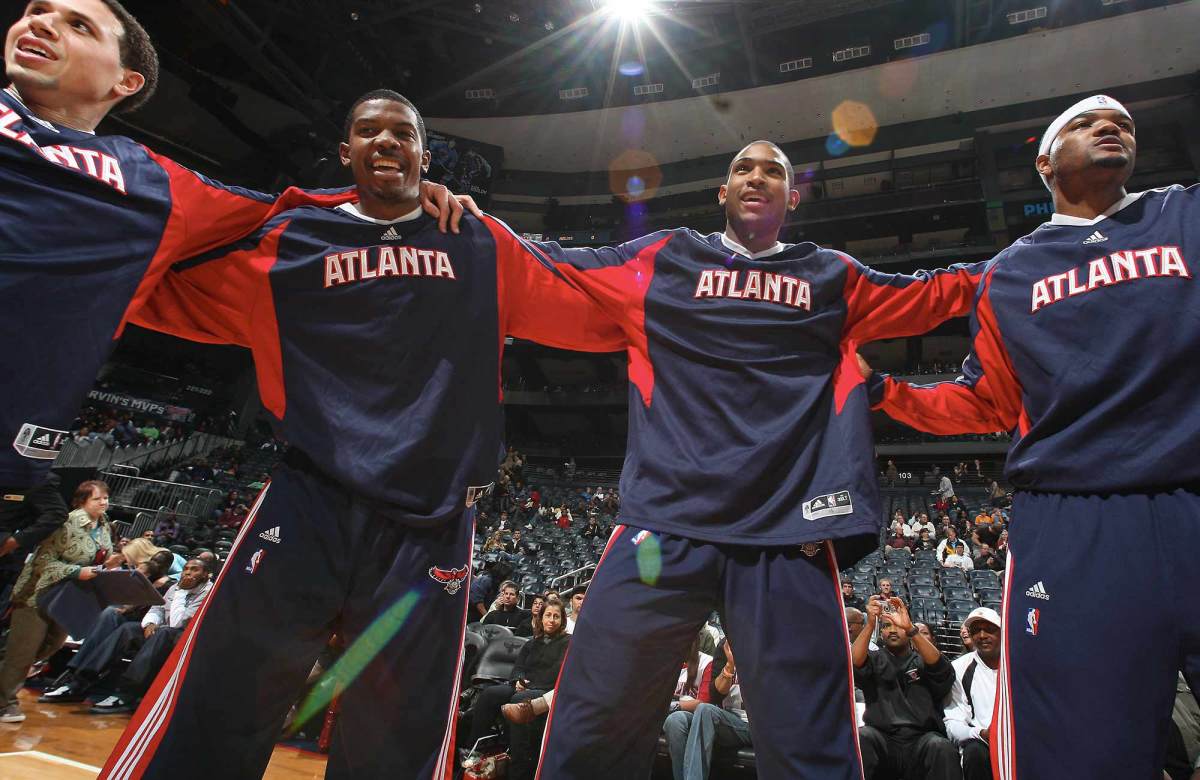
For 41 minutes a night, nearly everything ran through Johnson. It was him getting the youngest team in the league into its sets. It was his job to hunt for a shot when the play broke down. It came down to Johnson bringing up the ball and pounding it for full possessions at a time as he tried desperately to get things going. Those second thoughts came creeping back whenever Johnson’s methodical offense couldn’t keep up with the flood of scoring the Hawks would allow.
But the next year they’d win four more games. Then seven. Then 10.
“I just tried to make the best of it,” Johnson said. “And each and every year, man, we made a significant jump to where we was becoming a better team, better team. All of a sudden we get Al Horford and we're a playoff team. Every year, second round. We just could never break through that barrier, man, to where, y'know, we could make it to the Eastern Conference Finals or the Finals. But we had some great pieces.”
In the process, Johnson was widening his creative range as much as he could. Atlanta plunged him into pick-and-roll after pick-and-roll and let Johnson figure out the rest. With continued usage, all sorts of interesting wrinkles began to develop in Johnson’s game. Those low crossovers started getting even sharper and stretching further. Inside-out dribbles gave Johnson even more openings to slink through on his way to the basket. His length and his height became a more direct presence in his offensive game as he learned to use them to their fullest. All he had to do was get by his defender—and then he could seal them off completely by basically boxing them out of the play while keeping his dribble.
“You're not getting back in front of me,” Johnson said. “If I get in front of my man on the pick-and-roll and you behind me, you're dead. It's over with.”
It was the start of a shift in the way that Johnson used his body. And the idea came from seeing it play out on—let’s say a much smaller scale.
“Man, just watching some of the great point guards in this league,” Johnson said. “That was just—pretty much all visual. When I say watching some of the great point guards, you look at CP, a guy who I love to watch playing pick-and-roll because CP would always do that. And if he get you on his back or his hip, there wasn't no getting around him. So I'm thinking alright, at 6-8, if I could do that, cool. I could be a problem.”
Those kinds of moves, in essence, gave way to a new persona. Atlanta weaned off its pick-and-roll game over the course of a few years and started leveraging Johnson’s newfound tricks to separate a single opponent and attack them directly. Johnson had the moves to get a defender retreating and the strength to separate for a jumper. “Iso Joe” was born. The first time that Johnson heard that name was during his Atlanta days.
“It was a stat,” Johnson said. “I can't even remember the reporter's name. He said, he came to me one day, he was like: 'Man, you play the most one-on-one ball in the league. You have more isos than anybody in the league. Than LeBron, D-Wade, A.I.' I'm like, 'What?' He's like, 'Yeah.' From that point on, I just kinda remember. I would hear Iso Joe, Iso Joe. And then, y'know, when I started hitting like big shots, game winners, that's when it just really kinda came in the fold.”
Iso Joe became infamous and undeniable. The style of grinding out these tough, two-point jumpers against a single defender, it was all a bit regressive considering that the rest of the league was pushing for space and ball movement. Where it made sense was in its simplicity. Atlanta would be guaranteed a reasonably effective shot despite its lack of reliable guard play. And when the alternatives are Mike Bibby and Acie Law, Iso Joe starts to sound pretty good.
So for years Atlanta subsisted on Johnson’s back-downs and step-throughs. He got bigger and stronger to the point that he became one of the more physically imposing guards in the league. Working the post became natural. And that, in particular, is something that never could have happened if Johnson had stayed in Phoenix under Mike D’Antoni.
“It's just, we go by the numbers,” D’Antoni said. “And a great post player posting up is one of the worst offensive plays you can have. So, sorry! It's not that I'm like, 'Oh, wow, I'm trying to do something different.' It's just not a good play.”
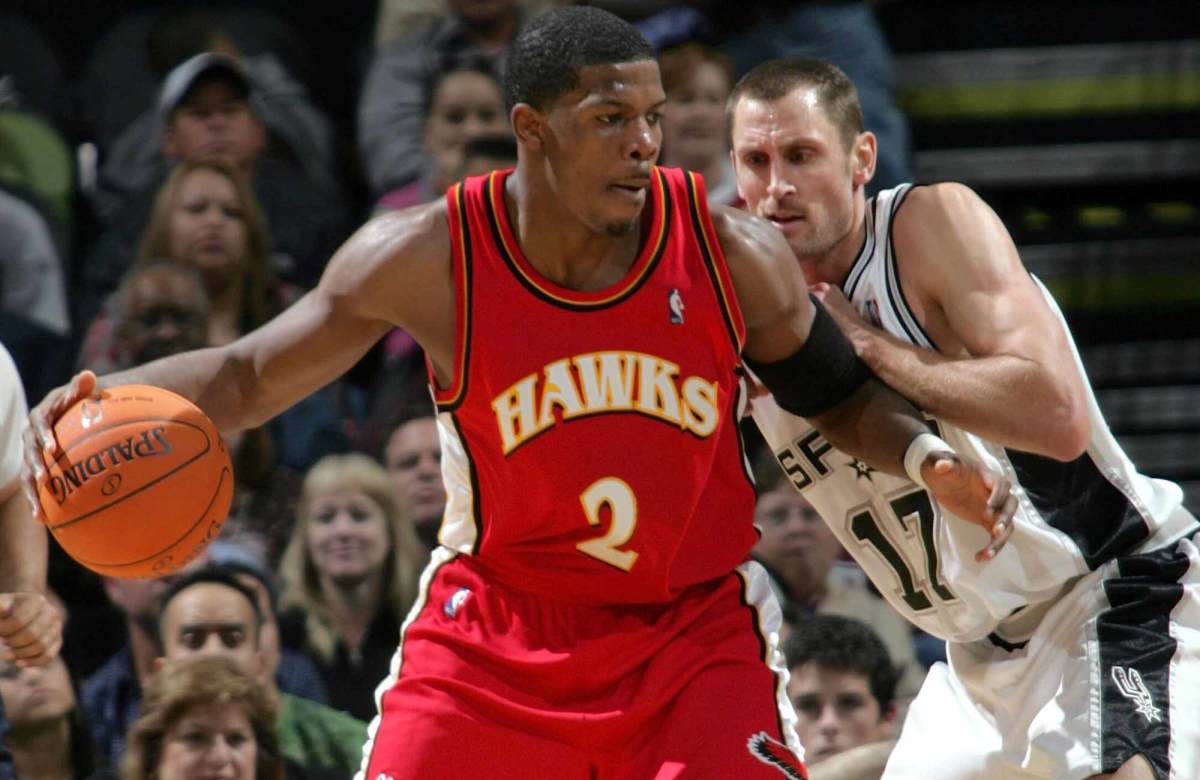
In a vacuum, D’Antoni is right. But for Johnson on those particular Hawks teams, it was among the most consistent scoring options available. That was especially true once Johnson really embraced the minimalism of the old-man game. He had some tutoring.
“It's gonna be funny but when we got Jerry Stackhouse in Atlanta, me and him we used to play one-on-one all the time,” Johnson said. “At that time, Stack was kinda—he was older in his career. So all he would do was get into my body, shoot his fadeaway. Or he'd get into my body on a post-up, pump fake, up-and-under. He'd always use his body. So I'm like, man. I've gotta learn this. So slowly but surely I started working on it. He was showing me little tips here and there and from that point on, man, that's how I've played since then. I play physical. When I post up, I want the contact, pump fake, whatever the case may be.”
Johnson did the best he could with that simplistic offense, but the whole notion of Iso Joe predictably went sour. The name itself took on an edge. It became as much a jab as it was a nod—a shot at Joe for the limitations of that approach and the perennially stale Hawks teams he played for. Accessories were shuffled around the core of Johnson, Horford, and Josh Smith, but nothing worked well enough to get Atlanta beyond the second round. The design had run its course.
“I had done everything that, or I’d tried to do everything I could in Atlanta,” Johnson said. “Obviously we came up short. So it was time for me to move on.”
What he moved on to was a team in pursuit of balance. The Brooklyn Nets acquired Johnson via trade to help stabilize a lineup with Deron Williams and Brook Lopez. Johnson’s usage would continue its downward creep, but Brooklyn sought him out because of all he could do as a scorer. He just had to scale down—kind of blending some of his approach in Phoenix with some of the skills he sharpened with Atlanta.
The NBA Is Finally Seeing The Real John Wall
“I've been there,” Johnson said. “I’ve been there. So it wasn't hard for me to come to the Nets and play off of D-Will and Brook. Whether they wanted me to spot up, whether they wanted me in pick-and-roll, whether they wanted me to post up, whether they wanted me in isolation. I done whatever coach Avery Johnson asked me to do and I tried to do it to the best of my abilities.”
D’Antoni once described Johnson as a “zero maintenance” player. That seemed to be clearest in Brooklyn, where his role would yo-yo along with the team’s needs on a particular night. The Nets later added Paul Pierce and Kevin Garnett to take a swing at the title, though in the process they muddled any sense of internal order the team might have had. There were times when Johnson’s iso work was instrumental. There were other games where he was better off shelving it to go back to his spot-up ways—punishing over-help as a defense keyed in on Lopez or Williams or Pierce. The only way a player like Johnson could catch the right groove as often as he did was by having a keen feel for the game.
That feel dictates where Johnson should be and how he should operate. “It’s knowing where to pass the ball before, before your teammate even knows it's coming,” Johnson said. “Seeing a play happen before it even really happens. That's a feel for me. Like, I can go watch some high school kids play and five minutes into the game I can tell who has a great feel for the game just by how they play in different speeds. For me that's having a great feel for the game, how you go from fast to slow to medium. That's what it's like for me.”
And as Johnson worked through his early 30s, those changes in speed were everything. “Fast” was probably out at that point, but Johnson’s small accelerations and decelerations got a defender rocking, which meant he could attack their off-balance foot or make contact to exploit their backward momentum. Thriving in isolation had made the feeling of slow-playing a possession really comfortable for Johnson. His sense of timing made him unflappable.
“Well, for me, I just kinda play at my own pace, man,” Johnson said. “I don't let nobody speed me up, so to speak. So I'm never gonna be in a rush. I'mma always take my time and take what the defense gives me.”
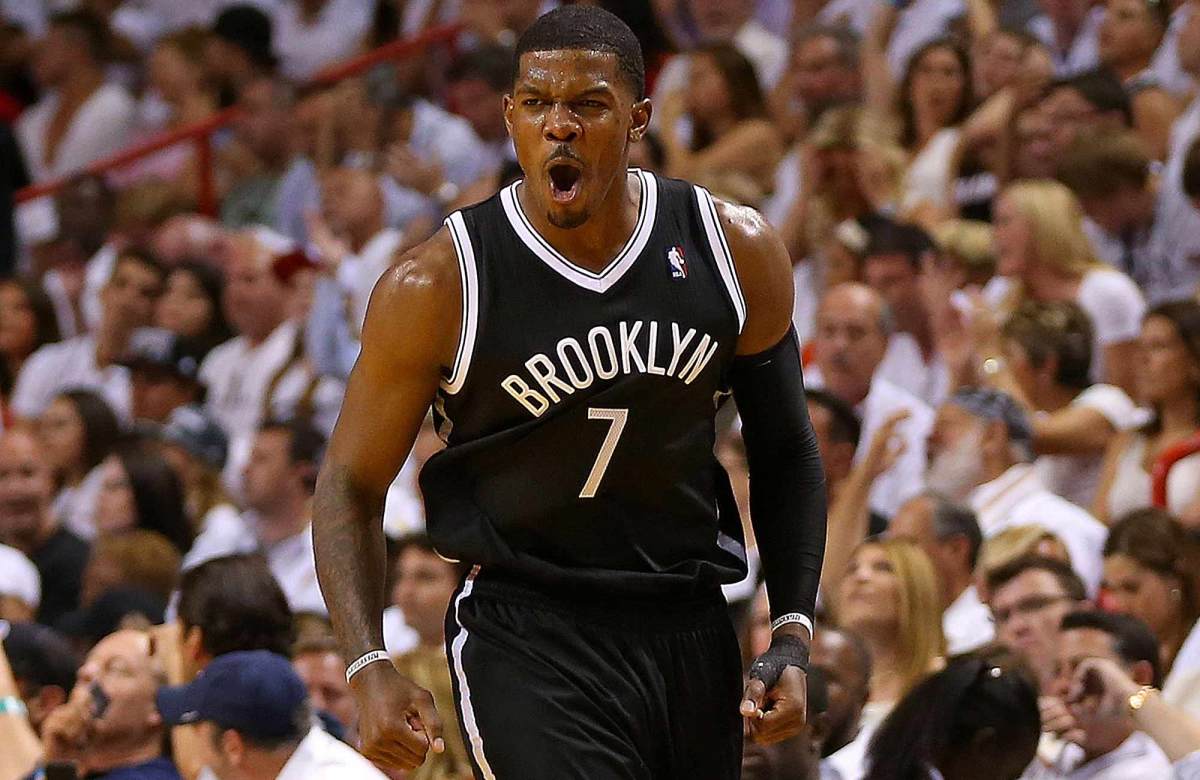
Part of the reason why some players fall off so quickly is that it’s hard to pinpoint the start of a decline in real time. At the point where it’s noticeable, it can almost be too late; what looked like a rough few months or a slow recovery from injury can turn out to be the sobering new normal. The tools that a player relied on his entire career can abandon him suddenly, leaving him to his own devices against a league that looks quicker and springier every second.
A below-the-rim game built on savvy and guile made Johnson the most anonymous star of his era. But the fact that he worked so consistently at lower speeds and lower altitudes makes the gradual slide to the end all the more graceful. A player can’t exactly transform without self-awareness. Johnson has it.
“I’ve never played with athleticism,” Johnson said. “My game, I was always a below-the-rim type guy. So my game didn't really change that much other than, yeah, I've lost a step or two. But for the most part, I'm still fairly decent in pick-and-rolls, catch-and-shoot pretty good, posting up pretty good, and just being a playmaker. Let alone, that's probably the biggest thing that I really pride myself on, man, making guys better. Those are the tools that I work on continuously every day. Just try not to let 'em leave.”
Johnson put all of those skills to work for the Nets without ever really losing himself in the process. Players respect that. Coaches, too, considering that they selected Johnson for the last of his All-Star appearances in 2014 when there were plenty of other qualified candidates. They saw a player who fit—no matter what was around him in Brooklyn.
Or, maybe, they just saw all the game-winners.
Johnson’s performance in late-game situations got so ridiculous in Brooklyn that when Jason Kidd left the Nets to coach the Bucks in 2014, he warned his team outright that a buzzer-beating possession would be going to Joe. There’s just something about being a big, elusive shooter that lends itself perfectly to clutch play. Just ask the Clippers, who took a game-winning buzzer beater from Johnson on their home floor in Game 1 of their first-round series. Two defenders thought they were all over the shot. Iso Joe just shrugged them off.
“Any time a coach believes in me to put the ball in my hand down the stretch, I'mma do whatever I can to try to get the best shot possible,” Johnson said. “That's what I've always done. Not only that: I think that coaches the I've played for, whether it was Mike Woodson, D'Antoni, Avery Johnson, Jason Kidd, Lionel Hollins, you know, those guys put me in great position man. We've had great, y'know, inbounds plays or timeout plays. It just kinda worked, man, for whatever reason. But I've always tried to impose my will on the player who's guarding me. Cause at the end of the game, when it's one-on-one and you're down one or its a tie game, nobody's helping. Nobody's double-teaming at that point cause no one wants their man to score. So it's just me and my man one-on-one and I always felt like I had the advantage.”
The countless isos in Atlanta gave him good reason to. It was a broad ability translated to these single moments. Johnson would never bear the full weight of an offense ever again. But everything that made him suitable for it in the first place helped to create that precious space for a game-winning jumper to soar.
There wasn’t a falling out in Brooklyn—just a fizzle. Pierce left in free agency. Garnett was sent back to Minnesota. Deron Williams was bought out. The partial season that would end Johnson’s Nets career was especially lifeless. He still showed up—there just wasn’t much point for a team that would win 21 games. Eventually, the Nets just waived Johnson, too, in the middle of the season. Call it an act of mercy.
Once he was cut loose, Johnson surveyed the market to find one team that had a lot of what he was looking for: the Miami Heat.
There were more promising contenders, but none positioned to give Johnson a particularly meaningful role. Miami had that going for it. The lineup would take some reimagining, but there was room for Johnson between Dwyane Wade, Goran Dragic, Hassan Whiteside, and Luol Deng. That was a group with the talent and flexibility to do interesting things. Johnson only spent 38 games there between the regular season and the playoffs, but that was enough for a sort of whirlwind romance. It was a perfect situation: a veteran team that gave Johnson room to operate but not so much responsibility it would be uncomfortable. And in D’Antoni fashion, Heat coach Erik Spoelstra made it all work by shifting the positions of a few key players to roll small.
“We had a great team,” Johnson said. “He moved Luol Deng to the 4, I'm playing 3, D-Wade at the 2, Goran Dragic at the 1 and Whiteside at the 5. I felt, man, we had a complete team. I felt we had what we needed to compete with Cleveland in the East. Unfortunately, injuries are part of the game.”
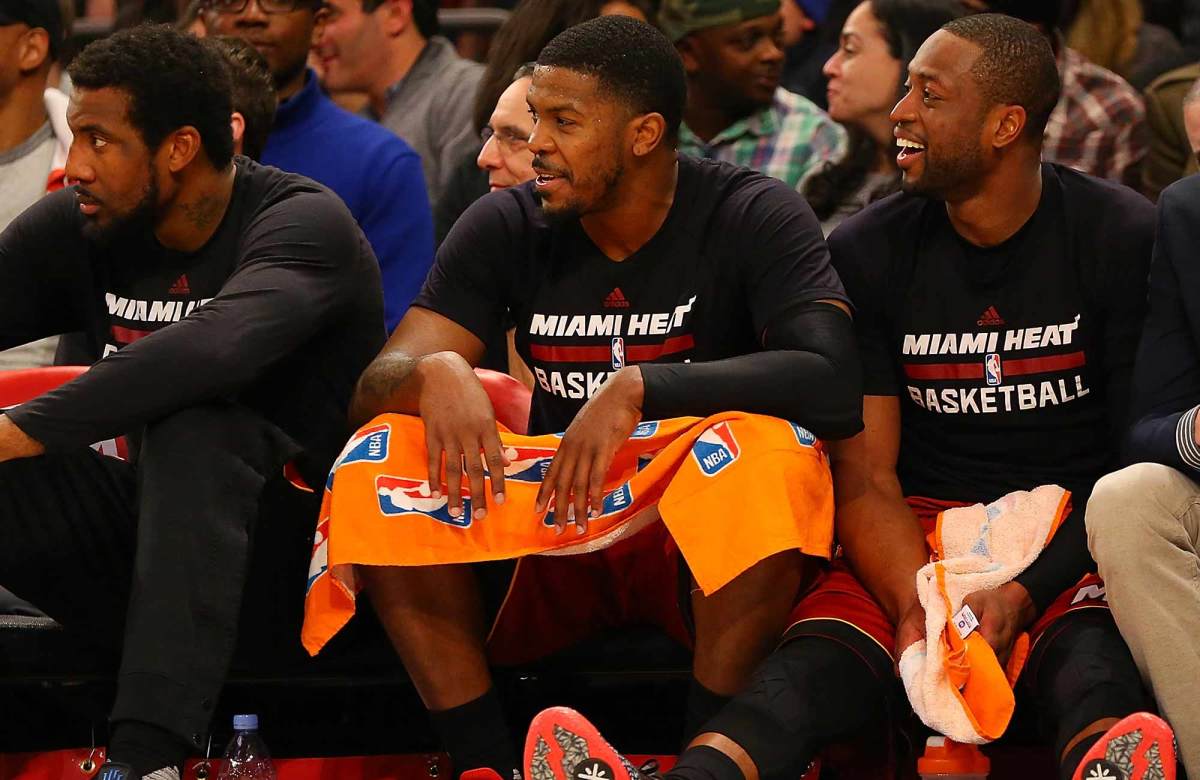
As promising as the opportunity had seemed, Miami just wasn’t equipped to handle compounding knee injuries to both Whiteside and Wade in the middle of a playoff run.
“Not only that, but Game 2 of the Charlotte series in Miami, I strained my right achilles,” Johnson said. “But I never said nothin' about it. I came in and got my treatment but it was like I couldn't even push off to go left. So I couldn't even go by my man. It was tough. We managed to get through the series thanks to D-Wade but it was disheartening for me, man, cause I know what I came there for and I know I came there to help, y'know, D-Wade in tough situations. For me, man, that was tough.”
That Heat team dissolved quickly, with Johnson, Wade, and Deng all going their separate ways in free agency. Johnson found a home in Utah—a place where, for the first time in years, Johnson wouldn’t just be an addition. He could really help to build something new for a team that hasn’t made the playoffs since 2012. His primary goal: “Helping these young guys, man, along the way.” Johnson said. “A lot of 'em haven't even been in the playoffs, and if they have they didn't even play.”
“I think I can be a part of it. Obviously I'm coming off the bench. That's not a big deal to me but when I come in the game, man, I'm just trying to make something happen. Like I said, we've got so many guys that can score the ball, and here, in Utah, man, I think we have the complete team. We've got bigs who can play, defend, score. Wings who can defend, score. Point guards who can defend, score. You pretty much have everything you would want in a team. We got it right here in Utah. But we're so young, man, there's times we look like we could be the best time in the West but then there's times we look like we could be the worst. It's just kinda how it is. So we have to develop some time of consistency and identity on who we want to be as a team.”
Roundtable: Which NBA Lottery Team Has The Brightest Future?
Injuries throughout the season prevented us from getting a clear vision of what the Jazz should be, but their 51 wins in spite of those injuries speaks to the caliber of players involved. Rudy Gobert has shattered what seemed to be the ceiling on his potential. Gordon Hayward, a legit two-way star, has a more sophisticated game every season. George Hill is a perfect, unassuming complement and Derrick Favors a bit of a wild card considering how much time he’s missed and how important the flexibility to play small could ultimately be. Johnson is a part of that. After playing the point and splitting time between the wing spots for most of his career, Utah has found another latent transformation in Johnson as a floor-stretching power forward.
Think about how crazy that is considering where the NBA was in 2001, when Johnson’s career began. “It’s went from playing with two traditional bigs now to your 5 man might be 6-9 who can shoot the three,” Johnson said. “That wasn't like that when I first came into the league.”
Not at all. Johnson wouldn’t have had a prayer of guarding Tim Duncan or Chris Webber, but the nature of the position has changed radically. The physical demands on power forwards today have more to do with how quickly they can cover ground than anything else.
“The league has switched really to a pick-and-roll-type league,” Johnson noted. “Stretch fours who can shoot the three, fives who can shoot the three. And I've kinda kept up with the Joneses, so to speak.” Keeping up requires a lot more work than it used to. Rest has become critical; you can see pretty sizable fluctuations in Johnson’s performance these days based on his time off between games. He’s playing at a lower weight to help his joints. On the road, there is no higher priority than finding a well-regarded yoga studio. It’s measures like these that allows Johnson to still get to his spots after all this reinvention. It’s measures like these that brought him to 20,000 career points this season—making Johnson just the 42nd player in the history of the league to make it there.
And really, you know Johnson’s still got it because after a game against the Celtics this season, rookie Jaylen Brown found a sudden interest in weight training—all because the 35-year-old Johnson had pushed him around and worked him over. It was a classic case of a veteran taking full advantage.
“I remember that game because if you've got a rookie, if you've got a rookie guarding a vet, a lot of times he's probably gonna try to take advantage of that,” Johnson said. “Because there are gonna be mistakes that a rookie is gonna make, man, that he's not accustomed to doing. Things like, whether it's shooting the gap on a shooter when you should be trailing the whole time. He got caught a couple times like that that night where he shot the gap and gave me wide open threes. It's just part of the game, man. You have to live and learn but your experience is your best teacher.”
Fittingly, the Jazz want Johnson practicing in all trades. There’s some iso and some pick-and-roll in there, leaner variations of what he gave the Hawks. The same floor spacing that unlocked the Heat has made the Jazz a better offensive team with Johnson on the floor. But you can’t play in a Quin Snyder offense without being a willing ball mover—the same kind that D’Antoni relied on to keep the Suns fluid. And it should surprise no one that Johnson essentially operates as a co-lead in crunch time, where he went nuts in the regular season and already sealed up one playoff game in Utah’s favor. The Jazz need Joe Johnson in all his forms.
“I’ve always felt that I was a pretty versatile guy and that whatever situation I was put in, I felt like I could flourish in it,” Johnson said. “I started off in this league as a defender playing with Boston. I knew I had to defend my but off to stay on the court because scoring, they didn't need that from me. So it just kinda—then I turned into like a spot-up shooter playing with Nash. And then I go into an isolation guy playing in Atlanta. Back to a spot-up guy pretty much, setting guys up and now I'm still, this time in my career, I'm basically playing off guys.”
“I've reinvented myself a few times. Honestly, I still feel like to this day I still have to come out and prove myself. Believe it or not, 16 years in this league. Like I still have to prove different things. But I have no problem with it. I enjoy it, man. I'm a fairly quiet guy. I'm always gonna be—I'm never gonna be the center of attention, never wanted to be the center of attention so I didn't, I didn't, it wasn't like I went to Atlanta wanting the spotlight cause I never wanted that. I just wanted to help lead the guys in the right direction. So I'm always gonna be like in the back, chilling, you won't even know I'm in the room. So that's—if you watch me play, you can kinda sense it. That's how I am.”
